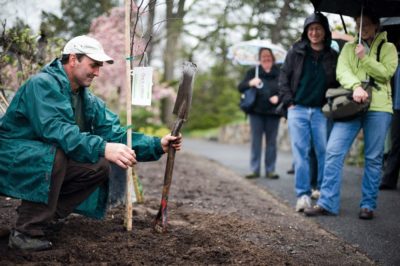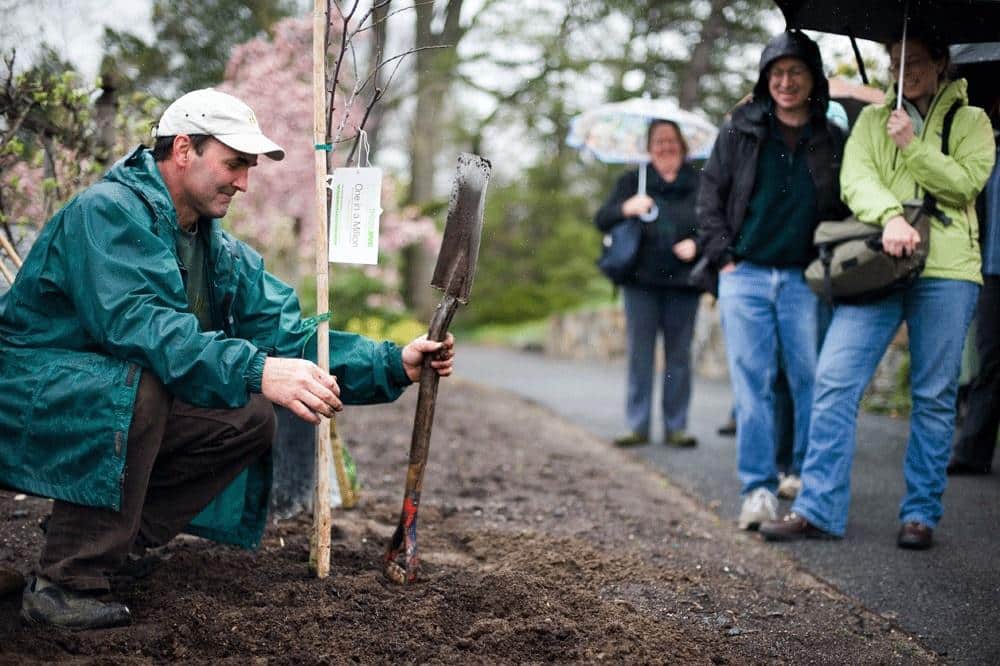
There are lots of great reasons for planting new trees at your home. For starters, a well-placed tree can help you save money on your utility bills. In the summer, a tree that helps shade your roof and windows can help cool the house. In the winter, an evergreen tree can help block cold winds. Both of these scenarios will help cut your electricity bill … naturally!
Of course, we also like to plant trees because they’re good for us – they provide us with lots of clean, fresh oxygen, not to mention they’re pretty to look at and enjoy, which is good for our mental health. And, if you’re a food gardener like me, you probably appreciate the apple trees, fig trees, and other fruit- and nut-bearing trees available. I only wish I had more land at my little homestead to plant an entire orchard!
1. Choosing a tree.
You can purchase trees for planting at a local nursery or order them and have them delivered right to your home.
I like to use a trusted local nursery when I can. They can recommend a tree that is native or adaptive to your specific climate, and can give recommendations on those trees that grow best in your area. You probably know this already, but it bears repeating: Not every tree will grow in every climate. And even if they will grow in your climate, it doesn’t mean they will thrive or produce. So, pick a tree that is happy in your area and it will serve you well.
Live A More Self-Reliant Life!
2. Choosing a site for your tree
One of the most important steps in planting a tree happens before you even put the tree in the ground. You need to pick the best location for your tree. Choose wisely. You want to plant a tree where it has plenty of room to grow and for the roots to expand, without causing damage to any existing structures. Don’t plant too close to the house or near power lines, driveways and walkways. Also avoid areas where there are water lines, gas lines, cable lines or sewer lines. If in doubt, call your utility providers before digging.
Once you’ve picked a good location, dig a test hole. This is also an important step. You don’t want to plant a tree where there are large rocks buried underground. If you hit a large rock, other tree roots, or any large obstructions, start over with a new hole and new location. You will need to dig an adequate size hole when you plant your tree, so make sure you have plenty of room to work.
Tip: When buying new trees to plant, bigger isn’t always better. Smaller, “baby” size trees are often much easier to plant, less expensive to purchase, and may actually grow quicker than a larger tree. Patience can really pay off when it comes to buying and planting new trees.
3. Planting your tree.
You will want to dig the hole about three times as wide as the root ball of your tree. The hole does not need to be as deep; the depth of your container is adequate enough. After digging the hole, use a shovel or pick to break up the soil around the sides of the hole. This will give your roots a better chance to adapt to the native soil.
Carefully remove the tree from its container and place it into the hole for planting. If you are dealing with a really large tree, you will likely need help with this step. (Another great reason to plant smaller trees!) Gently loosen the roots if they are too tightly wound together. Fill your hole with native soil, not bagged soil or compost. This will get the tree acclimated to the soil it will be growing in and will encourage the roots to expand outwards.
As you fill the hole back up with native soil, gently tamp the soil down with your foot to help release air pockets. Repeat several times while filling. After filling, use extra soil to support the base of the tree and create a small mound around the base of the tree and the edge of the hole. Water thoroughly and deeply to get your tree off to a great start. Cover the soil with a 2-3 inch layer of quality organic mulch to help keep water in. You will need to water your tree approximately every two weeks during the winter if there isn’t any rain or snow to do the job for you.
